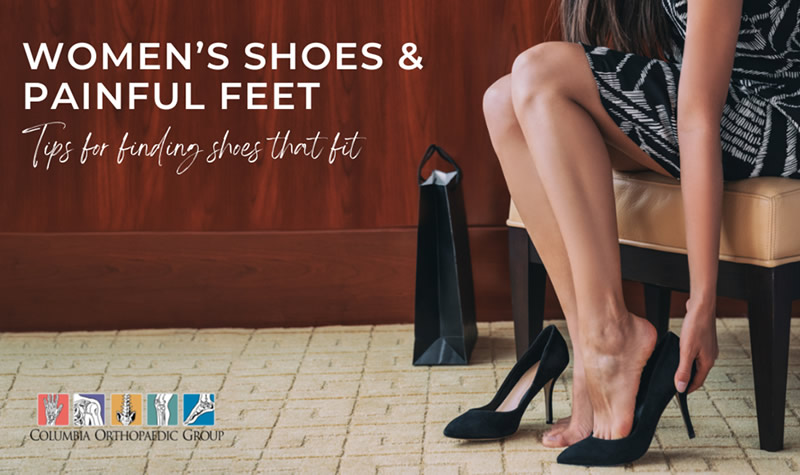
Tips for Finding Shoes that Fit
Shoes, although certainly protective, have been blamed as a principal cause of forefoot problems currently observed in women. These problems: hammertoes, bunions, Tailor's bunions, and corns, are mainly a result of improper design and fitting of shoes. Also, many women try to wear the same shoe size as they get older.
As a result, women wear shoes that are smaller than their feet, contributing to significant foot pain and deformity. As foot length increases, forefoot width also appears to increase, but heel width does not change significantly. To avoid painful and deformity constriction of the forefoot, women with longer feet may therefore need a shoe with a combination last, which has disproportionate forefoot and hindfoot widths.

Tips:
- Fit shoes while standing at the end of the day, when feet are largest.
- Make certain that the foot does not bulge over the welt (the strip of leather or other material that joins the upper with the outer sole).
- The toes should have room to extend, and the toe box should be ample. The end of the longest toe of the biggest foot should be within ½ inch (a fingerbreadth) of the end of the toe box.
- The forefoot should not feel tight in the shoe. The heel counter should grip the heel relatively snugly. Women who have a large discrepancy between forefoot width and heel width require a combination last (i.e. narrow heel and wide forefoot) to ensure an accurate fit.
- Whenever possible, you should purchase shoes made of soft leather or suede, and should avoid shoes made of patent leather or synthetic materials that have no "give."
- Shoes should fit comfortably at the time of purchase, and should not be bought with the expectation that they will stretch to fit. There should be no "break-in" period for shoes.
- If necessary, discrepancies between the foot size and shoe fit can be corrected with shoe inserts provided by a trained shoe technician or pedorthist. It is far preferable, however, for you to be well informed and to purchase shoes that fit correctly.
- You should select shoes that accommodate foot length and provide ample space in the toe box.
Comfort/Walking Shoes
- New Balance
- Propet
- Brooks
- Etonic
- Saucony
- Dunham
- Apex Ambulators
- Urban Walkers
- Rockport
- Soft Spots Supremes Drew
- SAS - Freetime (women) SAS - Timeout (men) Mephisto
- Ecco
- Naturalizer (women)
- Easy Spirit (women)
- PW Minor
- Hoka
- Sequoia
- KURU
Dress Shoes
- Rockport
- Sequoia
- Mephisto
- Ecco
- Finn Comfort
- Birkenstock - Tatami
- Naot
- Drew
- Munro
- Dunham
- Allen Edmond - CorpCasual (men) Florsheim - Comfort Tech (men) Alden (men)
- Clark (women)
- Joseph Seibel (women)
- Tesse-Tori (women)
- Thersia (women)
Economy Shoes
- EZ Strider
- Dr. Scholl's
- Cross Trekkers (Payless)
Work Boots/Hiking Boots
- Dunham
- PW Minor
- Red Wing
- Lake of the Woods Chippewa
- LeHigh
Athletic/Running Shoes
- New Balance
- Saucony
- Propet
- Brooks
- Etonic
- Merrell
- Ryka
- Hoka
- Wilson - Tcch Walker
Understanding what shoes are best for your feet and how to take care of your overall foot health will significantly decrease the odds of developing foot problems now or in the future. However, if you're experiencing discomfort, pain, or even foot deformity that won't go away, our foot and ankle specialists are here to help. Doctors Kurt Krautman and Brian Kleiber are experts in their field, bringing a wealth of knowledge and experience to the table. Both are currently accepting new patients and look forward to assisting you with all your foot & ankle needs.
Schedule an appointment today!


